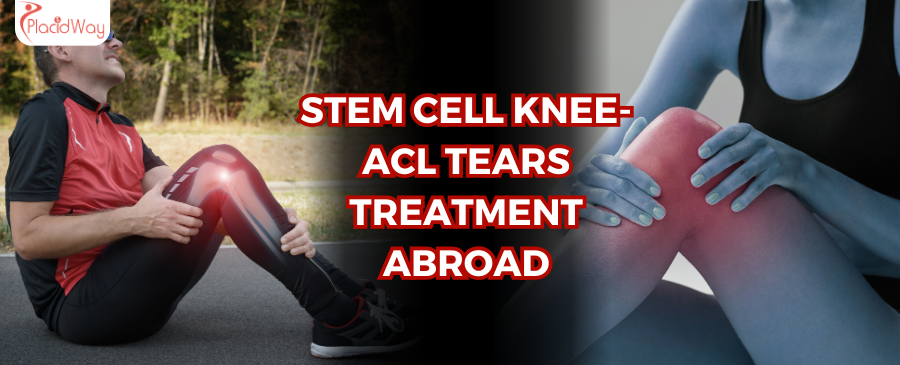
A sudden pivot on the basketball court, an awkward landing during a ski run, or a direct hit in a football game—these are all common scenarios that can lead to one of the most feared injuries for athletes and active individuals: a torn Anterior Cruciate Ligament (ACL). This crucial ligament in the knee provides stability, and an injury can mean months of pain, instability, and a long road to recovery, which traditionally involves reconstructive surgery. For many, the thought of going under the knife, followed by a lengthy and demanding rehabilitation process, is a daunting prospect. It often means significant time away from sports, work, and daily activities.
Fortunately, the landscape of orthopedic medicine is rapidly advancing, moving towards treatments that work with the body's innate ability to heal itself. Stem cell therapy for ACL tears is at the forefront of this revolution. This regenerative approach offers a minimally invasive alternative that aims to repair the damaged ligament tissue directly, rather than replacing it. By concentrating and injecting your own stem cells into the injured knee, doctors can create a powerful healing environment that reduces inflammation, eases pain, and stimulates the regeneration of the ligament. The prospect of avoiding surgery is compelling, and when combined with the high-quality, affordable care available through medical tourism, ACL treatment abroad with stem cells becomes an even more attractive option. This guide will walk you through everything you need to know, from how the therapy works to what it costs in different parts of the world.
What Exactly is an ACL Tear?
The ACL is located in the center of the knee and controls rotation and the forward movement of the shin bone (tibia). Most ACL injuries are non-contact, resulting from sudden stops, changes in direction, or landing incorrectly from a jump. People often hear or feel a "pop" in their knee at the moment of injury, followed by immediate swelling and a feeling that the knee is "giving way."
Tears are typically graded on a scale:
- Grade 1: The ligament is mildly damaged and slightly stretched but is still able to keep the knee joint stable.
- Grade 2: The ligament is stretched to the point of becoming loose. This is often referred to as a partial tear.
- Grade 3: This is a complete tear of the ligament. It has been split into two pieces, and the knee joint is unstable.
While surgery is almost always recommended for Grade 3 tears, stem cell ACL treatment is emerging as a highly effective option for Grade 1 and 2 tears.
How Does Stem Cell Therapy Work for an ACL Tear?
The magic of this treatment lies in the properties of MSCs. These cells are "undifferentiated," meaning they can transform into other types of cells the body needs, including ligament cells (fibroblasts). When injected into the knee under precise image guidance (like ultrasound or fluoroscopy), they home in on the injured tissue and begin a multi-faceted healing process.
The stem cells orchestrate a healing response by:
- Reducing Inflammation: They have powerful anti-inflammatory properties that calm the irritated joint, providing initial pain relief.
- Signaling Other Cells: They release chemical messengers called cytokines and growth factors that recruit other healing cells from the blood and surrounding tissues to the site of injury.
- Self-Renewal: They can differentiate and create new, healthy ligament tissue to bridge the gap in a partially torn ACL.
What is the Cost of Stem Cell ACL Treatment Abroad?
The price of stem cell ACL treatment is influenced by several factors, including the geographic location of the clinic, the source of the stem cells (bone marrow vs. adipose tissue), the technology used for processing, and whether the treatment is for one or both knees. Since regenerative therapies are often not covered by insurance, cost is a major consideration for patients.
Choosing to have your ACL treatment abroad can provide access to the same advanced medical technology and expertise at a fraction of the cost. Countries popular for orthopedic medical tourism have lower overhead and operational expenses, allowing them to offer more competitive pricing.
| Region | Average Cost Range (USD) | Notes |
|---|---|---|
| United States | $8,000 - $25,000 | The highest costs are due to insurance systems and overhead. |
| Germany / Western Europe | $7,000 - $18,000 | High standards of care, but also high operational costs. |
| Mexico / Panama | $5,000 - $15,000 | Popular medical tourism hubs with advanced facilities. |
| Thailand / Malaysia | $4,000 - $12,000 | Excellent value with JCI-accredited hospitals. |
Can Stem Cells Fully Heal a Completely Torn ACL?
The primary challenge with a complete tear is the large gap between the two ends of the severed ligament. Stem cells need a scaffold or structure to grow upon to bridge such a significant gap. However, research is rapidly advancing. Some innovative procedures combine surgery with stem cell therapy. In these hybrid approaches, a surgeon will perform an ACL reconstruction and then inject stem cells to accelerate the healing of the new graft and reduce the risk of re-injury.
For patients with partial tears, however, the results of stem cell therapy for ACL tears are very promising. The goal is to heal the existing ligament to prevent it from progressing to a full tear and to avoid the need for future surgery altogether.
What is the Recovery Time Compared to Surgery?
After a stem cell injection, the initial recovery focuses on protecting the joint while the cells begin the healing process. This usually involves a few days of rest, followed by a carefully structured physical therapy program. The rehabilitation is crucial, but is generally less aggressive than post-surgical rehab because there are no incisions, grafts, or tunnels drilled into the bone to heal from.
In contrast, ACL surgery is a major operation that requires a long and challenging recovery. The first few weeks are focused on managing pain and swelling, followed by months of physical therapy to regain range of motion, strength, and finally, sport-specific function. Non-surgical ACL repair with stem cells allows the body to bypass much of this trauma.
Ready to Get Back in the Game Without Surgery?
An ACL injury doesn't have to mean a year on the sidelines. PlacidWay connects you with leading international clinics specializing in advanced stem cell therapy for knee injuries. Discover safe, affordable, and effective alternatives to surgery and start your journey back to an active life.
Stem Cell Therapy Abroad





.png)

.png)
.png)

Share this listing